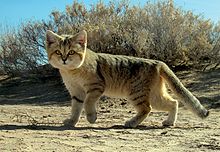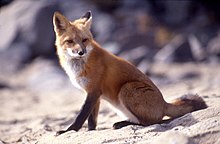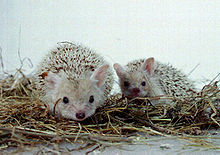List of mammals of Turkmenistan
This is a list of the mammal species recorded in Turkmenistan. There are eighty-three mammal species in Turkmenistan, of which one is critically endangered, three are endangered, twelve are vulnerable, and five are near threatened.[1]
The following tags are used to highlight each species' conservation status as assessed by the International Union for Conservation of Nature:
| EX | Extinct | No reasonable doubt that the last individual has died. |
| EW | Extinct in the wild | Known only to survive in captivity or as a naturalized populations well outside its previous range. |
| CR | Critically endangered | The species is in imminent risk of extinction in the wild. |
| EN | Endangered | The species is facing an extremely high risk of extinction in the wild. |
| VU | Vulnerable | The species is facing a high risk of extinction in the wild. |
| NT | Near threatened | The species does not meet any of the criteria that would categorise it as risking extinction but it is likely to do so in the future. |
| LC | Least concern | There are no current identifiable risks to the species. |
| DD | Data deficient | There is inadequate information to make an assessment of the risks to this species. |
Order: Artiodactyla (even-toed ungulates)[]

The even-toed ungulates are ungulates whose weight is borne about equally by the third and fourth toes, rather than mostly or entirely by the third as in perissodactyls. There are about 220 artiodactyl species, including many that are of great economic importance to humans.
- Family: Cervidae (deer)
- Subfamily: Cervinae
- Genus: Cervus
- Central Asian red deer C. hanglu LC[2]
- Bactrian deer, C. h. bactrianus[2]
- Central Asian red deer C. hanglu LC[2]
- Genus: Cervus
- Subfamily: Cervinae
- Family: Bovidae (cattle, antelope, sheep, goats)
- Family: Suidae (pigs)
Order: Carnivora (carnivorans)[]



There are over 260 species of carnivorans, the majority of which feed primarily on meat. They have a characteristic skull shape and dentition.
- Suborder: Feliformia
- Family: Felidae (cats)
- Subfamily: Felinae
- Genus: Caracal
- Caracal, C. caracal LC[9]
- Genus: Felis
- Jungle cat, F. chaus LC[10]
- African wildcat, F. lybica
- Asiatic wildcat, F. l. ornata
- Sand cat, F. margarita LC[11]
- Turkestan sand cat, F. m. thinobia
- Genus: Lynx
- Eurasian lynx, L. lynx LC[12]
- Genus: Otocolobus
- Pallas's cat, O. manul LC[13]
- Genus: Caracal
- Subfamily: Pantherinae
- Subfamily: Felinae
- Family: Hyaenidae (hyaenas)
- Family: Felidae (cats)
- Suborder: Caniformia
- Family: Ursidae (bears)
- Genus: Ursus
- Brown bear, U. arctos LC[21] presence uncertain
- Syrian brown bear, U. a. syriacus presence uncertain
- Brown bear, U. arctos LC[21] presence uncertain
- Genus: Ursus
- Family: Mustelidae (mustelids)
- Genus: Lutra
- Eurasian otter, L. lutra NT[22]
- Genus: Martes
- Beech marten, M. foina LC[23]
- Genus: Meles
- Caucasian badger, M. canescens NE
- Genus: Mellivora
- Honey badger, M. capensis LC[24]
- Genus: Mustela
- Steppe polecat, M. eversmannii LC[25]
- Least weasel, M. nivalis LC[26]
- Genus: Vormela
- Marbled polecat, V. peregusna VU[27]
- Genus: Lutra
- Family: Phocidae (earless seals)
- Genus: Pusa
- Caspian seal, P. caspica EN
- Genus: Pusa
Order: Chiroptera (bats)[]
The bats' most distinguishing feature is that their forelimbs are developed as wings, making them the only mammals capable of flight. Bat species account for about 20% of all mammals.
- Family: Vespertilionidae
- Subfamily: Myotinae
- Genus: Myotis
- Lesser mouse-eared bat, M. blythii LC[28]
- Geoffroy's bat, M. emarginatus LC[29]
- Natterer's bat, M. nattereri LC[30]
- Genus: Myotis
- Subfamily: Vespertilioninae
- Genus: Eptesicus
- Bobrinski's serotine, E. bobrinskoi DD
- Botta's serotine, E. bottae LC
- Genus: Eptesicus
- Subfamily: Miniopterinae
- Genus: Miniopterus
- Common bent-wing bat, M. schreibersii VU[31]
- Genus: Miniopterus
- Subfamily: Myotinae
- Family: Molossidae
- Genus: Tadarida
- European free-tailed bat, T. teniotis LC[32]
- Genus: Tadarida
- Family: Rhinolophidae
- Subfamily: Rhinolophinae
- Genus: Rhinolophus
- Blasius's horseshoe bat, R. blasii LC[33]
- Bokhara horseshoe bat, R. bocharicus LC
- Mediterranean horseshoe bat, R. euryale NT[34]
- Greater horseshoe bat, R. ferrumequinum LC[35]
- Lesser horseshoe bat, R. hipposideros LC[36]
- Genus: Rhinolophus
- Subfamily: Rhinolophinae
Order: Erinaceomorpha (hedgehogs and gymnures)[]
The order Erinaceomorpha contains a single family, Erinaceidae, which comprise the hedgehogs and gymnures. The hedgehogs are easily recognised by their spines while gymnures look more like large rats.
- Family: Erinaceidae (hedgehogs)
- Subfamily: Erinaceinae
- Genus: Hemiechinus
- Long-eared hedgehog, H. auritus LC
- Genus: Paraechinus
- Brandt's hedgehog, P. hypomelas LC
- Genus: Hemiechinus
- Subfamily: Erinaceinae
Order: Lagomorpha (lagomorphs)[]
The lagomorphs comprise two families, Leporidae (hares and rabbits), and Ochotonidae (pikas). Though they can resemble rodents, and were classified as a superfamily in that order until the early 20th century, they have since been considered a separate order. They differ from rodents in a number of physical characteristics, such as having four incisors in the upper jaw rather than two.
- Family: Leporidae (hares etc.)
- Genus: Lepus
- Tolai hare, L. tolai LC
- Genus: Lepus
- Family: Ochotonidae (pikas)
- Genus: Ochotona
- Afghan pika, O. rufescens LC
- Genus: Ochotona
Order: Perissodactyla (odd-toed ungulates)[]
The odd-toed ungulates are browsing and grazing mammals. They are usually large to very large, and have relatively simple stomachs and a large middle toe.
- Family: Equidae (horses etc.)
- Genus: Equus
- Onager, E. hemionus NT[37]
- Turkmenian kulan, E. h. kulan EN
- Onager, E. hemionus NT[37]
- Genus: Equus
Order: Rodentia (rodents)[]
Rodents make up the largest order of mammals, with over 40% of mammalian species. They have two incisors in the upper and lower jaw which grow continually and must be kept short by gnawing. Most rodents are small though the capybara can weigh up to 45 kg (99 lb).
- Suborder: Sciurognathi
- Family: Sciuridae (squirrels)
- Subfamily: Xerinae
- Tribe: Xerini
- Genus: Spermophilopsis
- Long-clawed ground squirrel, S. leptodactylus LC
- Genus: Spermophilopsis
- Tribe: Marmotini
- Genus: Marmota
- Menzbier's marmot, M. menzbieri VU
- Genus: Spermophilus
- Yellow ground squirrel, Spermophilus fulvus
- Genus: Marmota
- Tribe: Xerini
- Subfamily: Xerinae
- Family: Gliridae (dormice)
- Subfamily: Leithiinae
- Genus: Dryomys
- Forest dormouse, Dryomys nitedula
- Genus: Myomimus
- Masked mouse-tailed dormouse, Myomimus personatus VU
- Genus: Dryomys
- Subfamily: Glirinae
- Genus: Glis
- Iranian edible dormouse, Glis persicus
- Genus: Glis
- Subfamily: Leithiinae
- Family: Dipodidae (jerboas)
- Subfamily: Allactaginae
- Genus: Allactaga
- Small five-toed jerboa, Allactaga elater
- Great jerboa, Allactaga major
- Severtzov's jerboa, Allactaga severtzovi
- Mongolian five-toed jerboa, Allactaga sibirica
- Genus: Allactodipus
- Bobrinski's jerboa, Allactodipus bobrinskii
- Genus: Allactaga
- Subfamily: Dipodinae
- Genus: Dipus
- Northern three-toed jerboa, Dipus sagitta
- Genus: Eremodipus
- Lichtenstein's jerboa, Eremodipus lichtensteini
- Genus: Jaculus
- Turkmen jerboa, Jaculus turcmenicus
- Genus: Paradipus
- Comb-toed jerboa, Paradipus ctenodactylus
- Genus: Stylodipus
- Thick-tailed three-toed jerboa, Stylodipus telum
- Genus: Dipus
- Subfamily: Allactaginae
- Family: Calomyscidae
- Genus: Calomyscus
- Great Balkhan mouse-like hamster, Calomyscus mystax
- Genus: Calomyscus
- Family: Cricetidae
- Subfamily: Arvicolinae
- Genus: Blanfordimys
- Afghan vole, Blanfordimys afghanus
- Genus: Ellobius
- Southern mole vole, Ellobius fuscocapillus
- Northern mole vole, Ellobius talpinus
- Zaisan mole vole, Ellobius tancrei
- Genus: Microtus
- Persian vole, Microtus irani
- Tien Shan vole, Microtus kirgisorum
- Transcaspian vole, Microtus transcaspicus
- Genus: Blanfordimys
- Subfamily: Arvicolinae
- Family: Muridae (mice, rats, voles, gerbils, hamsters)
- Subfamily: Gerbillinae
- Genus: Meriones
- Libyan jird, Meriones libycus LC
- Midday jird, Meriones meridianus
- Persian jird, Meriones persicus
- Tamarisk jird, Meriones tamariscinus
- Zarudny's jird, Meriones zarudnyi EN
- Genus: Rhombomys
- Great gerbil, Rhombomys opimus LC
- Genus: Meriones
- Subfamily: Murinae
- Genus: Nesokia
- Short-tailed bandicoot rat, Nesokia indica LC
- Genus: Nesokia
- Subfamily: Gerbillinae
- Family: Sciuridae (squirrels)
Order: Soricomorpha (shrews, moles, and solenodons)[]
The "shrew-forms" are insectivorous mammals. The shrews and solenodons closely resemble mice while the moles are stout-bodied burrowers.
- Family: Soricidae (shrews)
- Subfamily: Crocidurinae
- Genus: Crocidura
- Lesser white-toothed shrew, C. suaveolens LC[38]
- Genus: Diplomesodon
- Piebald shrew, D. pulchellum LC
- Genus: Crocidura
- Subfamily: Soricinae
- Tribe: Soricini
- Genus: Sorex
- Eurasian pygmy shrew, S. minutus LC
- Genus: Sorex
- Tribe: Soricini
- Subfamily: Crocidurinae
Locally extinct[]
The following species are locally extinct in the country:
See also[]
References[]
- ^ This list is derived from the IUCN Red List which lists species of mammals and includes those mammals that have recently been classified as extinct (since 1500 AD). The taxonomy and naming of the individual species is based on those used in existing Wikipedia articles as of 21 May 2007 and supplemented by the common names and taxonomy from the IUCN, Smithsonian Institution, or University of Michigan where no Wikipedia article was available.
- ^ a b Brook, S.M.; Donnithorne-Tait, D.; Lorenzini, R.; Lovari, S.; Masseti, M.; Pereladova, O.; Ahmad, K. & Thakur, M. (2017). "Cervus hanglu". IUCN Red List of Threatened Species. 2017: e.T4261A120733024.
- ^ IUCN SSC Antelope Specialist Group (2017). "Gazella subgutturosa". IUCN Red List of Threatened Species. 2017: e.T8976A50187422.
- ^ IUCN SSC Antelope Specialist Group (2018). "Saiga tatarica". IUCN Red List of Threatened Species. 2018: e.T19832A50194357.
- ^ Weinberg, P. & Ambarli, H. (2020). "Capra aegagrus". IUCN Red List of Threatened Species. 2020: e.T3786A22145942.
- ^ Michel, S. & Rosen Michel, T. (2015). "Capra falconeri". IUCN Red List of Threatened Species. 2015: e.T3787A97218336.
- ^ Michel, S. & Ghoddousi, A. (2020). "Ovis vignei". IUCN Red List of Threatened Species. 2020: e.T54940655A54940728.
- ^ Keuling, O. & Leus, K. (2019). "Sus scrofa". IUCN Red List of Threatened Species. 2019: e.T41775A44141833.
- ^ Avgan, B.; Henschel, P. & Ghoddousi, A. (2016). "Caracal caracal". IUCN Red List of Threatened Species. 2016: e.T3847A102424310.
- ^ Gray, T.N.E.; Timmins, R.J.; Jathana, D.; Duckworth, J.W.; Baral, H. & Mukherjee, S. (2016). "Felis chaus". IUCN Red List of Threatened Species. 2016: e.T8540A50651463.
- ^ Sliwa, A.; Ghadirian, T.; Appel, A.; Banfield, L.; Sher Shah, M. & Wacher, T. (2016). "Felis margarita". IUCN Red List of Threatened Species. 2016: e.T8541A50651884.
- ^ Breitenmoser, U.; Breitenmoser-Würsten, C.; Lanz, T.; von Arx, M.; Antonevich, A.; Bao, W. & Avgan, B. (2015). "Lynx lynx". IUCN Red List of Threatened Species. 2015: e.T12519A121707666.
- ^ Ross, S.; Barashkova, A.; Dhendup, T.; Munkhtsog, B.; Smelansky, I.; Barclay, D. & Moqanaki, E. (2020). "Otocolobus manul". IUCN Red List of Threatened Species. 2020: e.T15640A162537635.
- ^ Stein, A. B.; Athreya, V.; Gerngross, P.; Balme, G.; Henschel, P.; Karanth, U.; Miquelle, D.; Rostro, S.; Kamler, J.F. & Laguardia, A. (2016). "Panthera pardus". IUCN Red List of Threatened Species. 2016: e.T15954A102421779.
- ^ AbiSaid, M. & Dloniak, S.M.D. (2015). "Hyaena hyaena". IUCN Red List of Threatened Species. 2015: e.T10274A45195080.
- ^ Hoffmann, M.; Arnold, J.; Duckworth, J. W.; Jhala, Y.; Kamler, J. F. & Krofel, M. (2018). "Canis aureus". IUCN Red List of Threatened Species. 2018: e.T118264161A46194820.
- ^ Boitani, L.; Phillips, M. & Jhala, Y. (2018). "Canis lupus". IUCN Red List of Threatened Species. 2018: e.T3746A119623865.
- ^ Hoffmann, M. & Sillero-Zubiri, C. (2015). "Vulpes cana". IUCN Red List of Threatened Species. 2015: e.T23050A48075169.
- ^ Murdoch, J.D. (2014). "Vulpes corsac". IUCN Red List of Threatened Species. 2014: e.T23051A59049446.
- ^ Hoffmann, M. & Sillero-Zubiri, C. (2016). "Vulpes vulpes". IUCN Red List of Threatened Species. 2016: e.T23062A46190249.
- ^ McLellan, B. N.; Proctor, M. F.; Huber, D. & Michel, S. (2017). "Ursus arctos". IUCN Red List of Threatened Species. 2017: e.T41688A121229971.
- ^ Roos, A.; Loy, A.; de Silva, P.; Hajkova, P. & Zemanová, B. (2015). "Lutra lutra". IUCN Red List of Threatened Species. 2015: e.T12419A21935287.
- ^ Abramov, A.V.; Kranz, A.; Herrero, J.; Krantz, A.; Choudhury, A. & Maran, T. (2016). "Martes foina". IUCN Red List of Threatened Species. 2016: e.T29672A45202514.
- ^ Do Linh San, E.; Begg, C.; Begg, K. & Abramov, A. V. (2016). "Mellivora capensis". IUCN Red List of Threatened Species. 2016: e.T41629A45210107.
- ^ Maran, T.; Skumatov, D.; Abramov A. V. & Kranz, A. (2016). "Mustela eversmanii". IUCN Red List of Threatened Species. 2016: e.T29679A45203762.
- ^ McDonald, R. A.; Abramov, A. V.; Stubbe, M.; Herrero, J.; Maran, T.; Tikhonov, A.; Cavallini, P.; Kranz, A.; Giannatos, G.; Kryštufek, B. & Reid, F. (2019). "Mustela nivalis". IUCN Red List of Threatened Species. 2019: e.T70207409A147993366.
- ^ Abramov, A.V.; Kranz, A. & Maran, T. (2016). "Vormela peregusna". IUCN Red List of Threatened Species. 2016: e.T29680A45203971.
- ^ Juste, J. & Paunović, M. (2016). "Myotis blythii". IUCN Red List of Threatened Species. 2016: e.T14124A22053297.
- ^ Piraccini, R. (2016). "Myotis emarginatus". IUCN Red List of Threatened Species. 2016: e.T14129A22051191.
- ^ Gazaryan, S.; Kruskop, S.V. & Godlevska, L. (2020). "Myotis nattereri". IUCN Red List of Threatened Species. 2020: e.T85733032A22052584.
- ^ Gazaryan, S.; Bücs, S. & Çoraman, E. (2020). "Miniopterus schreibersii". IUCN Red List of Threatened Species. 2020: e.T81633057A151216401.
- ^ Benda, P. & Piraccini, R. (2016). "Tadarida teniotis". IUCN Red List of Threatened Species. 2016: e.T21311A22114995.
- ^ Taylor, P. (2016). "Rhinolophus blasii". IUCN Red List of Threatened Species. 2016: e.T19515A21972073.
- ^ Juste, J. & Alcaldé, J. (2016). "Rhinolophus euryale". IUCN Red List of Threatened Species. 2016: e.T19516A21971185.
- ^ Piraccini, R. (2016). "Rhinolophus ferrumequinum". IUCN Red List of Threatened Species. 2016: e.T19517A21973253.
- ^ Taylor, P. (2016). "Rhinolophus hipposideros". IUCN Red List of Threatened Species. 2016: e.T19518A21972794.
- ^ Kaczensky, P.; Lkhagvasuren, B.; Pereladova, O.; Hemami, M. & Bouskila, A. (2020). "Equus hemionus". IUCN Red List of Threatened Species. 2020: e.T7951A166520460.
- ^ Hutterer, R.; Amori, G.; Krystufek, B.; Yigit, N.; Mitsain, G. & Palomo, L.J. (2010). "Crocidura suaveolens". IUCN Red List of Threatened Species. 2010: e.T29656A9511068.
- ^ Durant, S.; Mitchell, N.; Ipavec, A. & Groom, R. (2015). "Acinonyx jubatus". IUCN Red List of Threatened Species. 2015: e.T219A50649567.
- ^ Goodrich, J.; Lynam, A.; Miquelle, D.; Wibisono, H.; Kawanishi, K.; Pattanavibool, A.; Htun, S.; Tempa, T.; Karki, J.; Jhala, Y. & Karanth, U. (2015). "Panthera tigris". IUCN Red List of Threatened Species. 2015: e.T15955A50659951.
External links[]
- "Animal Diversity Web". University of Michigan Museum of Zoology. 1995–2006. Retrieved 22 May 2007.
- Fauna of Turkmenistan
- Lists of biota of Turkmenistan
- Lists of mammals of Asia
- Mammals of Central Asia
- Lists of mammals by location
